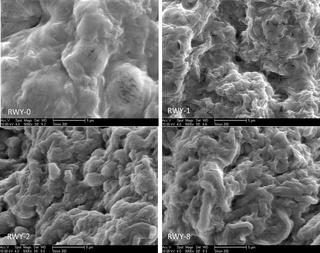PLOS ONE ( IF 3.7 ) Pub Date : 2018-09-21 , DOI: 10.1371/journal.pone.0204266 Yuhan Ma 1, 2, 3 , Qianqian Zhang 1, 2 , Qifu Zhang 1, 2 , Huaqi He 3 , Zhu Chen 1, 2 , Yan Zhao 3 , Da Wei 3 , Mingguang Kong 4 , Qing Huang 1, 2

|
As a traditional Chinese medicine, Ganoderma lingzhi has attracted increasing attention for both scientific research and medical application. In this work, in order to improve the production of polysaccharides from an original wide-type (WT) strain (named "RWY-0") of Ganoderma lingzhi, we applied atmospheric-pressure dielectric barrier discharge (DBD) nonthermal plasma to the protoplasts of RWY-0 for mutagenesis treatment. Through a randomly amplified polymorphic DNA (RAPD) assay, at least 10 mutagenic strains were confirmed. They also showed different mycelium characteristics in terms of shape, color, size and biomass in liquid fermentation. The mutant strains were examined by infrared spectroscopy, and based on the established near-infrared (NIR) quantification model, the polysaccharide contents in these mutants were quantitatively evaluated. As a result, we found that the Ganoderma polysaccharide contents in some of the mutant strains were significantly changed compared with that of the original WT strain. The polysaccharide content of RWY-1 G. lingzhi was considerably higher than that of the WT strain, with an increase of 25.6%. Thus, this preliminary work demonstrates the extension of the plasma mutagenesis application in acquiring polysaccharide-enhanced Ganoderma lingzhi mutants and shows the usefulness of NIR spectroscopy in the rapid screening of mutagenic strains for other important ingredients.
中文翻译:

等离子体诱变提高灵芝菌丝体多糖产量及红外光谱快速筛选突变菌株
灵芝作为传统中药,在科学研究和医疗应用方面日益受到重视。在这项工作中,为了提高灵芝原始宽型(WT)菌株(名为“RWY-0”)多糖的产量,我们将大气压介质阻挡放电(DBD)低温等离子体应用于原生质体RWY-0用于诱变处理。通过随机扩增多态性DNA(RAPD)检测,确认了至少10种致突变菌株。它们在液体发酵中还表现出不同的菌丝体特征,包括形状、颜色、大小和生物量。采用红外光谱法对突变株进行检测,并基于建立的近红外(NIR)定量模型对突变株中的多糖含量进行定量评价。结果发现,部分突变菌株中的灵芝多糖含量与原始WT菌株相比发生了显着变化。RWY- 1G的多糖含量。灵芝明显高于WT菌株,增加了25.6%。因此,这项初步工作证明了血浆诱变在获得多糖增强灵芝突变体中的应用的扩展,并显示了近红外光谱在快速筛选诱变菌株中其他重要成分的有用性。



























 京公网安备 11010802027423号
京公网安备 11010802027423号